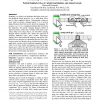Free Online Productivity Tools
i2Speak
i2Symbol
i2OCR
iTex2Img
iWeb2Print
iWeb2Shot
i2Type
iPdf2Split
iPdf2Merge
i2Bopomofo
i2Arabic
i2Style
i2Image
i2PDF
iLatex2Rtf
Sci2ools
CHI
2005
ACM
2005
ACM
Snap-and-go: helping users align objects without the modality of traditional snapping
Snapping is a widely used technique that helps users position graphical objects precisely, e.g., to align them with a grid or other graphical objects. Unfortunately, whenever users want to position a dragged object close to such an aligned location, they first need to deactivate snapping. We propose snap-and-go, a snapping technique that overcomes this limitation. By merely stopping dragged objects at aligned positions, rather than "warping" them there, snapand-go helps users align objects, yet still allows placing dragged objects anywhere else. While this approach of inserting additional motor space renders snap-and-go slightly slower than traditional snapping, snap-and-go simplifies the user interface by eliminating the need for a deactivation option and thereby allows introducing snapping to application scenarios where traditional snapping is inapplicable. In our user studies, participants were able to align objects up to 138% (1D) and 231% (2D) faster with snapand-go tha...
CHI 2005 | Human Computer Interaction | Snapping Technique | Traditional Snapping | Users Align Objects |
| Added | 30 Nov 2009 |
| Updated | 30 Nov 2009 |
| Type | Conference |
| Year | 2005 |
| Where | CHI |
| Authors | Patrick Baudisch, Edward Cutrell, Ken Hinckley, Adam Eversole |
Comments (0)

